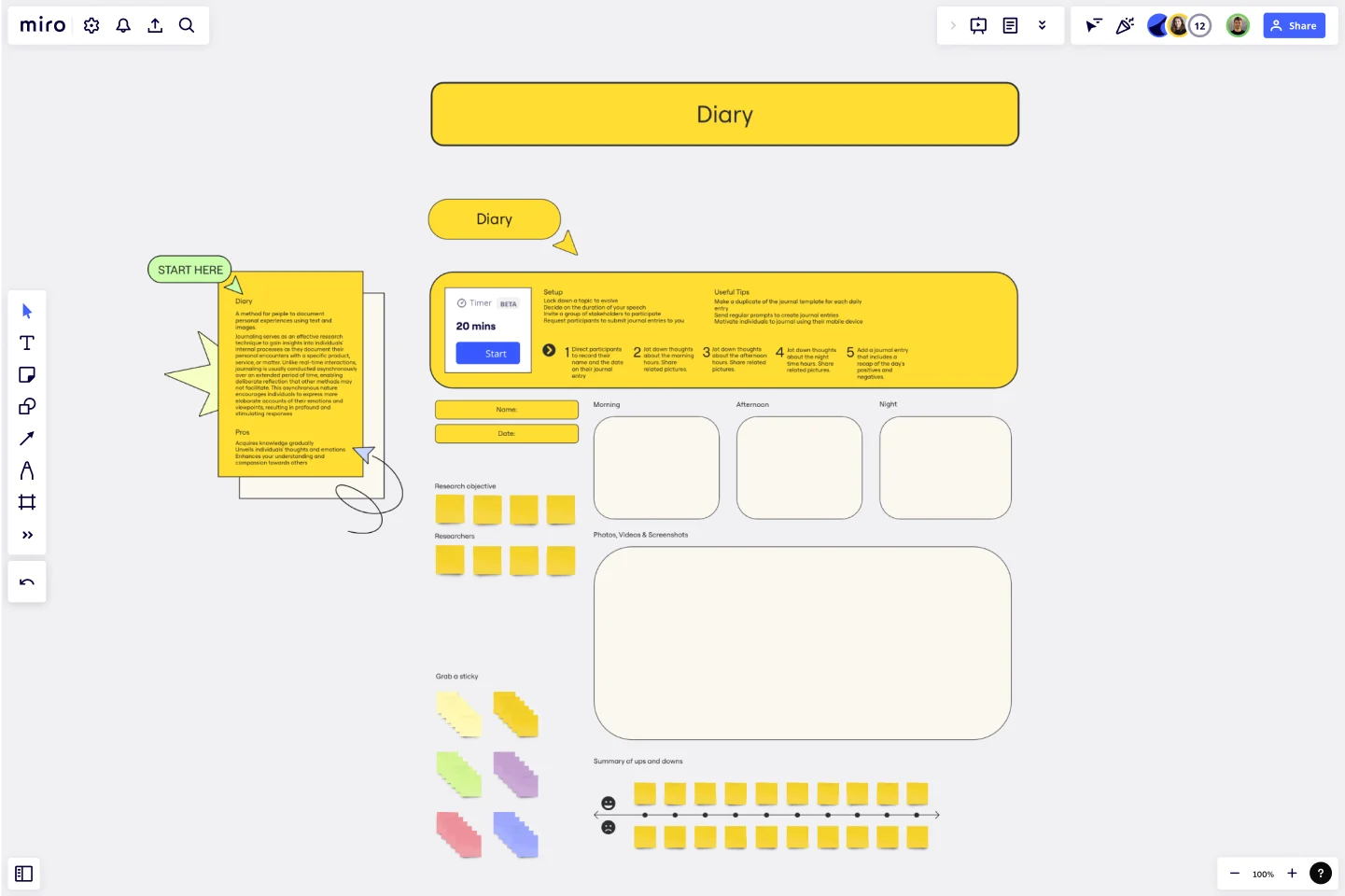Diary Template
Document personal experiences using text and images with the Diary Template.
About the Diary Template
The Diary Template is a valuable research tool for documenting experiences with a particular product, service, or subject over an extended period of time. It allows for a more thoughtful and deliberate reflection, enabling people to express emotions and viewpoints that may not have been conveyed in real-time interactions.
Journaling with the template provides a profound and in-depth understanding of people's internal processes that other research methods may not achieve. The reflective and introspective nature of journaling encourages people to share deep and insightful responses, resulting in a more comprehensive analysis of the subject being studied.
Benefits of using the template
Acquire knowledge gradually.
Unveil people's thoughts and emotions.
Enhance your understanding and compassion towards others.
How to use the template in Miro
Direct participants to record their name and the date on their journal entry
Jot down thoughts about the morning hours. Share related pictures.
Jot down thoughts about the afternoon hours. Share related pictures.
Jot down thoughts about the nighttime hours. Share related pictures.
Add a journal entry that includes a recap of the day's positives and negatives.
Setup
Lock down a topic to evolve.
Decide on the duration of your speech.
Invite a group of stakeholders to participate.
Request participants to submit journal entries to you.
Useful tips
Make a duplicate of the journal template for each daily entry.
Send regular prompts to create journal entries.
Motivate people to journal using their mobile devices.
Get started with this template right now.
Storyboarding Toolkit
Works best for:
Storyboard, Design, Planning
Streamline your storytelling process with the Storyboarding Toolkit. This comprehensive template provides all the tools you need to create detailed storyboards, including scene planning, character development, and timeline management. It's perfect for filmmakers, designers, and marketing teams looking to create cohesive and engaging narratives. Use this toolkit to organize your ideas, ensure consistency, and bring your stories to life with clarity and precision.
Moderated Usability Testing Template
Works best for:
Design
Encouraging individuals to express their implicit ideas helps identify the strengths and weaknesses of a design, and Moderated Usability Testing Template provides valuable perspectives. Typically, conducting only six to nine of these tests uncovers 80% of design issues, making it a cost-effective method to enhance potential solutions.
Service Blueprint Canvas
Works best for:
Research & Design
The IASA Service Blueprint Canvas helps visualize service interactions and processes in detail. This template is perfect for analyzing and improving service delivery. Use it to align teams, identify pain points, and enhance customer experiences. It's ideal for creating a shared understanding of service dynamics and fostering collaboration among stakeholders, ensuring a seamless and efficient service delivery process.
Service Blueprint by Sahar Naderi
Works best for:
Research & Design
Designed with usability in mind, this template features an intuitive layout that makes it easy to map out your service process from start to finish.
Practical Customer Journey Mapping by Alex Gilev
Works best for:
Customer Journey Map
Today, customers hold companies to high standards for product quality and user experience.
Prune the Product Tree Template
Works best for:
Design, Desk Research, Product Management
Prune the Product Tree (also known as the product tree game or the product tree prioritization framework) is a visual tool that helps product managers organize and prioritize product feature requests. The tree represents a product roadmap and helps your team think about how to grow and shape your product or service by gamifying feedback-gathering from customers and stakeholders. A typical product tree has four symbolic features: the trunk, which represents the existing product features your team is building; the branches, each of which represents a product or system function; roots, which are technical requirements or infrastructure; and leaves, which are new ideas for product features.
